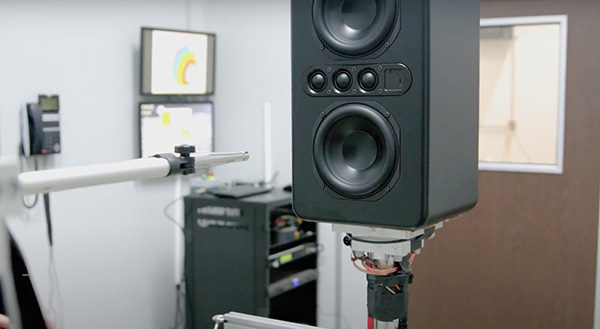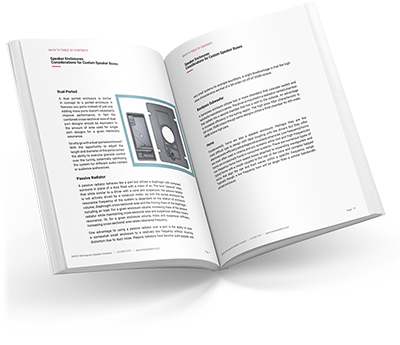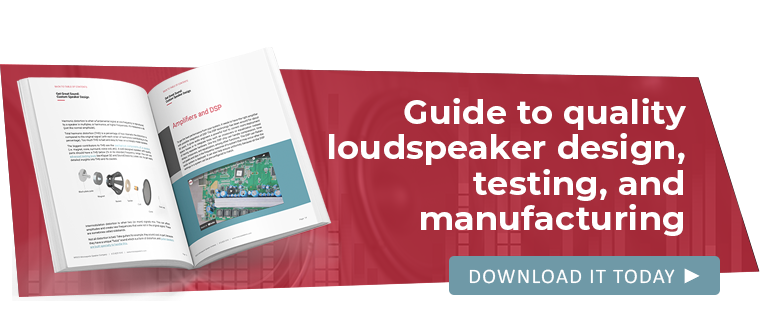Speaker Enclosures: Considerations for Custom Speaker Boxes
Menu
Introduction
A speaker enclosure for reproduction systems (i.e. not guitar) for the most part, works in conjunction with the speaker drivers (driver) to reinforce the low frequency range. This article aims to define some of the attributes fundamental to enclosure design and performance.
First thing is to define system objectives such as:
- Frequency range
- Loudness capability
- Directivity
- Physical size
- Materials
- Cost
MISCO’s engineers have the expertise and tools to help customers achieve their design objectives, no matter how complex. We easily translate those objectives into electromechanical technical specifications for loudspeaker drivers (driver), enclosures and electronics from prototypes to production, including best-in-class testing every step of the way. Some of MISCO’s customers are are audio experts and some are not experts in all aspects of audio. We’ve built this page as a resource on the subject of speaker enclosures and hope this will serve as a valuable jumping-off point as you research your options.
Loudspeaker Driver Characteristics
A well designed speaker system couples the loudspeaker drivers and the enclosure so that they complement each other acoustically. Optimizing the system design requires an understanding of how the components interact with each other and ideally, even the target type of listening space. Loudspeaker driver characteristics have been conveniently organized by a set of driver characteristics known as the Thiele/Small Parameters.
Thiele/Small Parameters
The world of speaker design is packed with audio acronyms used to describe speakers. The Thiele/Small (TS) Parameters are a series of characteristics based on a model of electrical and mechanical attributes of individual loudspeaker drivers. Neville Thiele and Richard Small (working independently) organized the electromechanical characteristics into a series of terms with definitive characteristics that can be used to mathematically model how the drivers will perform in enclosures. Together, the T/S parameters describe a model of each of the key mechanical, electrical, and electromechanical properties of a loudspeaker.
Speakers Q Factor
Definitively, Q factor is a dimensionless characteristic of losses of an oscillating system such as a mass and spring. In loudspeaker drivers this is a measure of the sum of the electrical damping—Qes, mechanical damping—Qms and the sum of total damping—Qts. A driver with high Qts is less damped, rings more as compared to a driver with low Qts. A general rule of thumb is a driver Qts of between 0.6 and 1.0 will perform best in a sealed enclosure and a driver with Qts less than 0.6 would benefit from a ported enclosure.
Speaker Enclosures
Speaker enclosures are not just a box to mount and transport drivers. The enclosure interacts with the driver as part of an electromechanical acoustic system to enhance the low frequency (bass) range. At the most basic level, the enclosure acts as a baffle to separate the acoustic radiation from the rear side of a driver cone from its front side, eliminating destructive interference.
An enclosure can be described as a baffle that has been closed on all sides to form a box. But there’s more to an enclosure. The internal volume of the enclosure acts as an air spring that interacts with the driver’s cone and suspension. Additionally, the enclosure acts as a resonant chamber that couples with the driver.
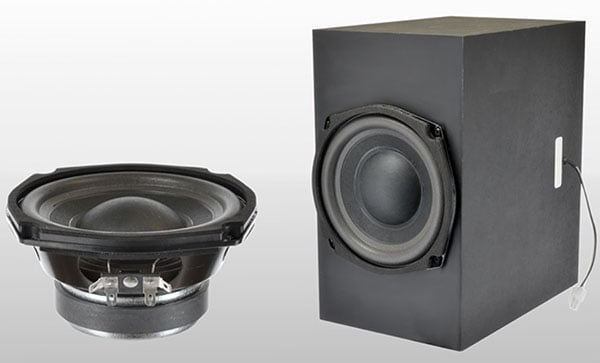
Types of Enclosures
There are a number of different types of enclosures, each interacting differently with the drivers and room. Size matters, not necessarily bigger is better but where the internal volume matches specifics for specific drivers.
Open Baffle
An open baffle, while technically not an enclosure, represents one of the simplest types of loudspeaker mounts and as mentioned in the introduction, serves to increase the distance sound wave must travel from the rear of the cone to the front of the cone. It is usually just a flat board onto which the loudspeaker is mounted. The term “infinite baffle” refers to a baffle size that relative to the acoustic wavelengths produced is infinitely large, to a point that low frequency sound waves from the rear of the driver cone do not reach around to interfere with the sound waves from the front of the cone.
Sealed Enclosure (Closed Box)
As the name suggests, sealed speaker enclosures are completely sealed so that no air can escape. They may also be referred to as an acoustic suspension enclosure since the enclosure acts as an air spring in conjunction with the cone. The design ensures the forward wave travels into the room while the rear wave remains in the box, essentially an infinite baffle.
The resonance frequency of the closed box system represents a 2nd order high pass filter. Below this frequency the acoustic output rolls off at 12dB/octave. Consequently for low frequencies these enclosures are less efficient requiring more amplifier power to achieve the same sound level as a vented enclosure at low frequencies.
Ported Enclosure (Bass Reflex or Vented Box)
A ported enclosure utilizes a port (duct) as a vent. The benefit is enhanced bass response below the resonance frequency of the driver & enclosure combination. The principal is that of a Helmholtz resonator. A simple example is the tone produced when blowing across the neck of a bottle, ultimately, the resonance frequency, defined by the bottle body volume in conjunction with the length and diameter of the neck. In a ported enclosure, the port acts as a tube inserted into the volume of the enclosure. Sound waves produced from the rear of the speaker cone at frequencies in the region of the Helmholtz resonance, are reinforced through the port, extending the low frequency (bass) output below that of a similar sealed enclosure.
The relation of enclosure volume, duct length and cross-sectional area determines the resonance frequency of the system. For a given enclosure volume, increasing duct length while maintaining cross-sectional area lowers resonance. Or, for a given enclosure volume and duct length, increasing cross-sectional area raises resonance frequency.
Ported enclosures can be more efficient, able to produce more low frequency sound level for a given amount of amplifier power than a sealed enclosure. A 4th order high pass filter is defined by the system resonance though in the ported enclosure the filter rolls off at 24dB/octave vs. 12dB/octave for the sealed system. A design consideration is that dependent on the duct diameter and length, as the air in the duct is oscillated, at very high velocity it can generate audible “chuffing” distortion. Given the relational interactions, tuning a somewhat small enclosure to a very low frequency requires a small cross-sectional area and long duct, potentially vulnerable to distortion.
Dual Ported
A dual ported enclosure is similar in concept to a ported enclosure. It features two ports instead of just one. Adding more ports doesn’t necessarily improve performance, in fact the combined cross-sectional area of dual-port designs should be equivalent to the amount of area used for single-port designs for a given Helmholtz resonance.
So why go with a dual-ported enclosure? With the opportunity to adjust the length and diameter of the ports comes the ability to exercise granular control over the tuning, potentially optimizing the system for different audio content or audience preferences.

Passive Radiator
A passive radiator behaves like a port but utilizes a diaphragm with compliant surround in place of a duct filled with a mass of air. The term “passive” infers that while similar to a driver with a cone and suspension, the passive radiator is not actively driven by a voice-coil motor. As with the ported enclosure the resonance frequency of the system is dependent on the relation of enclosure volume, diaphragm cross-sectional area and the moving mass of the diaphragm including air load. For a given enclosure volume, increasing mass of the passive radiator while maintaining cross-sectional area and suspension stiffness lowers resonance. Or, for a given enclosure volume, mass and suspension stiffness increasing cross-sectional area raises resonance frequency.
One advantage to using a passive radiator over a port is the ability to tune a somewhat small enclosure to a relatively low frequency without incurring distortion due to duct noise. Passive radiators have become quite popular with very small systems for example soundbars. A slight disadvantage is that the high pass characteristics are that of a 5th order roll off of 30dB/octave.
Bandpass Subwoofer
A band-pass enclosure utilizes two or more chambers that cascade sealed and helmholtz resonators in series. The driver is mounted in a sealed or vented chamber that radiate into a second chamber that has a vent to the outside. An advantage is increased efficiency in the tuning region. The high pass filter characteristic is 6th order, 36dB/octave though some designs utilize a third chamber for 8th order, 48dB/octave high pass.
Horns
Fundamentally, horns are also a speaker enclosure. Perhaps they are the most difficult type to design with ideal coupling with the drivers but they offer electroacoustic efficiency advantages not available otherwise. Low frequency horns are most often used in cinema and pro systems while mid and high frequencies horns are occasionally found in consumer systems. There are numerous types of low frequency horns from sealed boxes attached to expanding waveguides and hybrid horns with a mouth coupled to the rear of the cone and complex tapped horns that align the rear and front waves within a specific frequency range. Typically though, a low frequency horn will be larger than a similar bandwidth ported enclosure.
Enclosure Shape
Enclosure Baffle
A speaker’s baffle is the surface on which the speaker is mounted to the loudspeaker enclosure. The baffle can influence sound quality to the listening area because of diffraction effects from the baffle edges. Subwoofers may occasionally use the bottom or rear baffle to mount the driver.
Discover more with MISCO’s Loudspeaker 101 Guide.
Enclosure Shape
Enclosures are very often rectangular with parallel walls but they can be made in any shape. Non-rectangular shapes will have some benefit by not having parallel walls which can cause internal waves to reflect with interference. This is most important when the wavelengths are smaller than the internal dimensions, typically at mid and higher frequencies.
Mounting Considerations
Common speaker enclosure assembly and mounting mistakes reduce performance even when all design and engineering considerations have been carefully executed. Five common mistakes make up the majority of issues. Luckily, most of these can be resolved quickly once you learn to recognize them. They include:
- Ensure that there are no air leaks to isolate the rear waves from the front waves.
- Putting the speaker’s grille or cover too close to the speaker cone to eliminate striking.
- Creating an open space cavity directly in front of the speaker itself.
- Using the wrong materials for the gaskets for mounting that leak or buzz.
- Overtightening the screws, which can deform the speaker basket.
Two-Way (or More) Speaker Considerations
Crossovers divide the input signals so that in a two-way system low frequencies go to the bass driver and high frequencies to to the high frequency driver. In a three-way system, the mid-range crossover blocks low and high frequencies so that only the mid frequencies go to the mid-range driver. In a passive system the crossover is in circuit between the amplifier and drivers. In the active system an electronic or DSP crossover is in circuit before the amplifiers, referred to as a bi-amp system.
Bi-amping or tri-amping is an excellent way to improve sound quality in virtually any audio system. It enables greater control over your sound by using one amplifier to power low-frequency speakers and another to power high-frequency speakers (tweeters). This is ideal for application-specific sound settings.
Speaker Enclosure Materials
The ideal enclosure is completely stiff. As the cone oscillates, if the enclosure walls are not rigid, they can move. If the walls move, they are in essence vibrating like a diaphragm and can cause acoustical interference with the sound emanating from the cone, or buzzing. To be completely rigid, good enclosure design will balance materials and geometry for maximum stiffness.
Material choice should also consider the type and expectations of different types of systems. A bookshelf or home cinema surround speaker with a 5” driver does not require the same enclosure robustness as a 15” cinema subwoofer. The 5” might do well with 8mm to 12.5mm MDF (or even plastic) enclosure while the subwoofer would be best to have a stiff ≥19mm or 25mm MDF or plywood enclosure with internal bracing.
Wood and MDF
Traditionally, most speaker enclosures have been made from wood. Wood combines high durability, low weight, and the ability to absorb vibrations, all in a material that is easy to source and shape. Wood enclosures are ideal for those who are concerned about aesthetics and branding since it is very easy to add custom finishes to them. Medium-density fiberboard (MDF) is acoustically inert and denser than most alternatives, making it a reliable choice. Plywood offers improved robustness over MDF for portable systems. Baltic Birch plywood is very robust, the choice for optimum travel robustness.
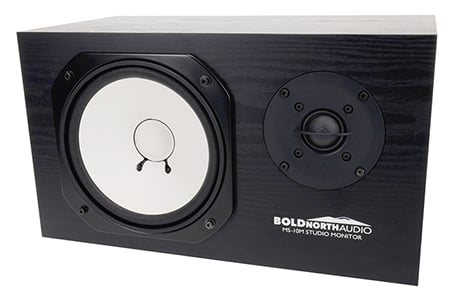
Plastic
When the thickness and composite makeup are both optimized, plastic speaker enclosures have the potential to be more rigid than those made from very thin wood. This means plastic can be more suitable in the long run when you expect to ramp up to high manufacturing volumes. Plastic is also more durable than wood when loudspeaker systems will mainly be used outdoors. Careful design will include internal ribbing that supports the plastic enclosure walls.
Grilles
The grille (spelled grill in some regions) is a hard or soft covering mounted directly over the face of the speaker driver. Grilles provide protection from the operating environment to stop debris or wandering fingers from damaging the drivers or getting into the enclosure through the ports. There is an inevitable trade-off between the amount of protection and how the grilles effect audio. Sound needs to pass through the grille, ideally unimpeded, so open area and material type and thickness, need to be optimized to reduce acoustical compromises. Soft fabric grills often impose little acoustic resistance but offer minimal water resistance and physical protection, while metal or plastic hard grills can impact sound quality or even frequency response and total sound output if not designed carefully with adequate open area. MISCO testing demonstrates that metal grilles can offer a superior sound experience when designed up to about to be 60% open area.
Enclosure Damping Material
Use of a damping materials inside the enclosure can reduce internal reflections and diminish resonances. Additionally, the difference in density vs. air can increase the apparent volume of the enclosure. Common materials are polyester, fiberglass, foam and mat fibers.
Rapid Prototyping
Printing Prototypes
3D printing, also referred to as additive manufacturing, is a method of fabricating system parts where layers of a material, are deposited one on top of the other to form a completed part. ABS and PLA thermoplastic filament is used in most 3D printing applications. With 3D printing, it is easy to experiment and test component designs that may be best for your system without committing to a large manufacturing run. Care must be given to ensure that materials and geometry combine to make a very stiff enclosure.
Protection from the Elements
Waterproofing and water resistance is essential when a loudspeaker system will be used outdoors. Direct exposure to rain (or other water) requires absolute waterproofing, but humidity and condensation should also be considered. This means a coating on the front side of the cone only. In other situations, the whole cone and all driver components including metalware as well as electronics and passive cross-overs may have special coatings.
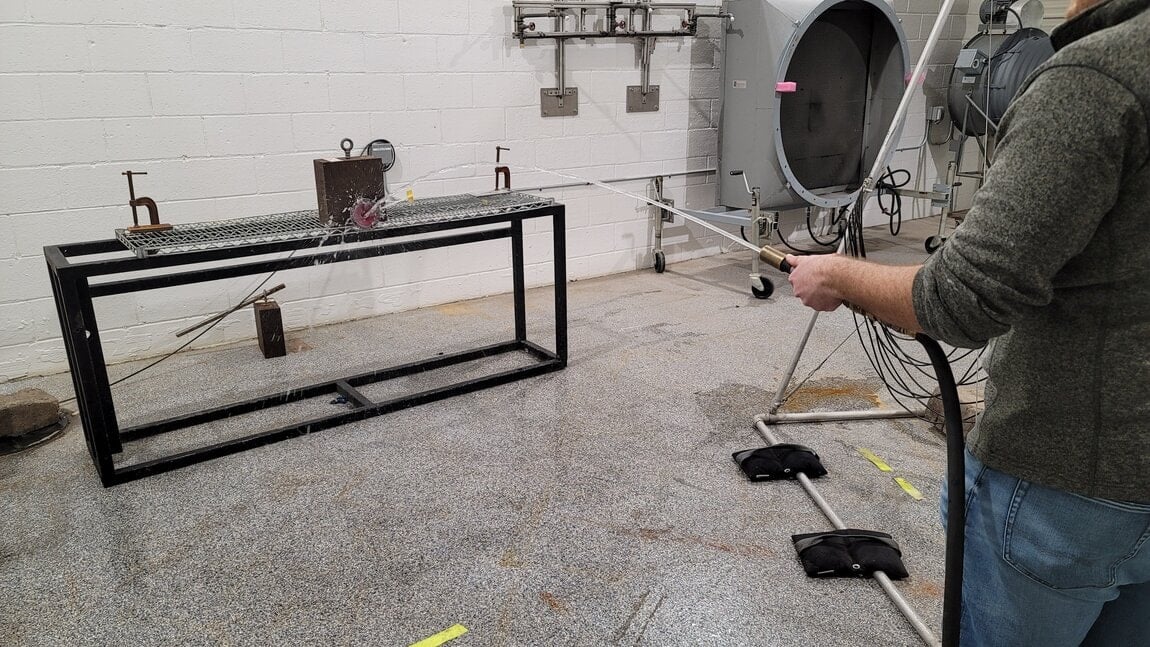
Final Speaker Testing
Testing is crucial to ensure that, after multiple phases of design, development, fabrication, and assembly, the end product meets all of your performance goals.
Testing occurs in two primary phases. The driver undergoes multiple tests before it ever enters the enclosure. Then, the entire finished speaker performance is tested. The impedance curve and frequency response curve are documented once testing is complete, helping with future equipment maintenance and performance management. Power capacity is tested at incremental levels to insure that the system is robust, even at the highest levels. Additionally, air leaks, loose screws, and reversed polarity are among the potential quality issues that must be satisfied.
MISCO's industry-leading approach to testing reflects our decades of experience and focus on superior audio engineering. To learn more about final testing, see our video Design Series #5: Enclosure and Final Testing.
With over 75 years of audio expertise, MISCO is with you every step of the way. Whether you want a truly top-of-the-line loudspeaker system customers will remember for years to come or wish to optimize for high-volume manufacturing, our team is here for you. Contact us to learn more or get started.
